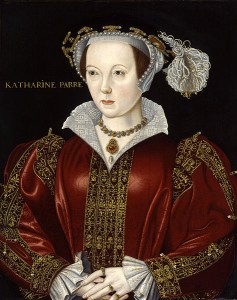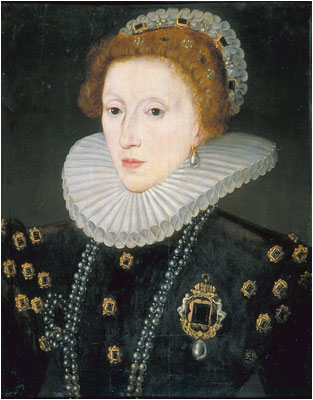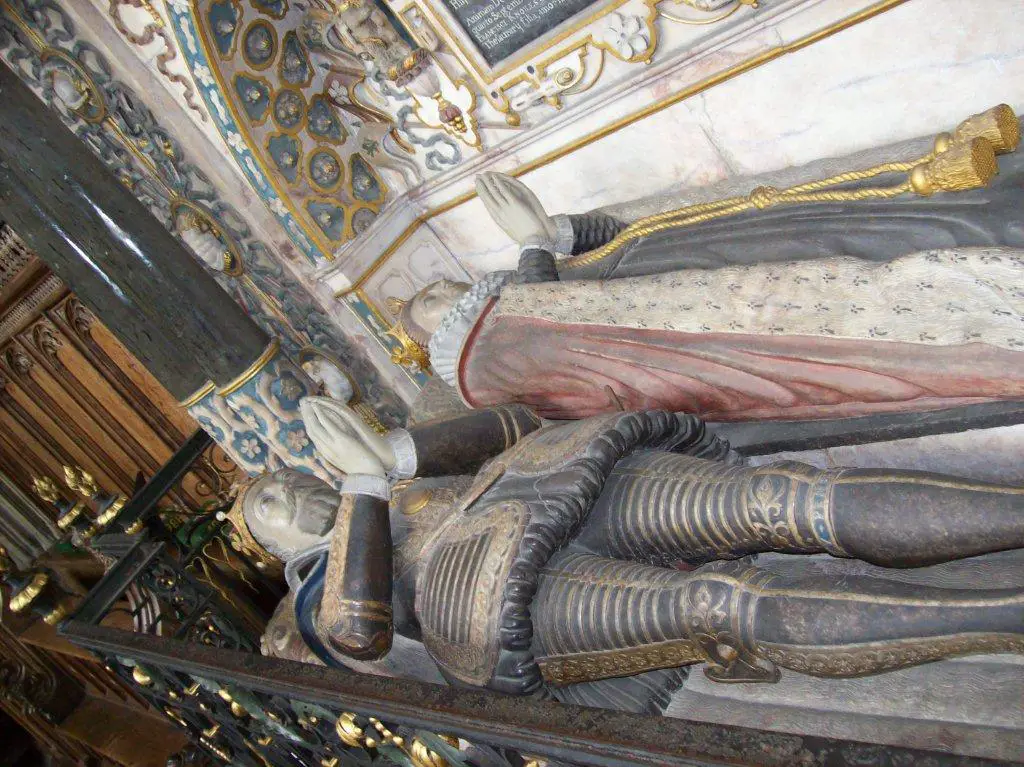Tragically, Catherine's father died on the 11th November 1517 when Catherine was just five years old. After her father's death, the care of Catherine and her siblings remained with their mother who went to great lengths to see her children well-educated. Maud Parr proved to be a very adept woman and managed to oversee her children's education as well as run the family estates. It would appear that Catherine held a love for learning and she became fluent in French, Latin and Italian. She also learned to read and write proficiently and appears to have held a strong interest in medicine.
Between April 1523 and March 1524, Catherine's mother attempted to arrange a marriage for her eldest daughter with Henry Scrope, son and heir of Lord Scrope of Bolton. However the marriage never came to be due to disagreements over the dowry and Henry Scrope died the following year. A marriage, however, was arranged between Catherine and Edward, son of Thomas Borough, 3rd Baron Borough of Gainsborough, in 1529. At the time, Edward was in his early twenties and Catherine was approximately seventeen. There are no reports on the relationship between Edward and Catherine, although it has been suggested that Edward's father was overbearing and perhaps even mentally ill. The marriage only last four years as in April 1533 Edward died. Catherine's mother had died on 1st December 1531, so when Edward died Catherine was left with nowhere to go. It is reported that she went to live with her cousins, the Stricklands of Sizergh Castle, Westmorland.
In the summer of 1534, Catherine married her second husband, John Neville, 3rd Baron Latimer of Snape Castle, Yorkshire. At forty-one, Neville was almost twice Catherine's age and he had been married twice previously, fathering two children. Upon her marriage, Catherine became Lady Latimer and stepmother to her husband's children.
During the late months of 1536 the Pilgrimage of Grace broke out in the North. The rebellion formed as a series of revolts which originated in Lincolnshire. The people were unhappy with the dissolution of their Abbey in Louth, upset with many of the government commissions in the area which were being conducted to look at the resources that the smaller monasteries had as well as the conduct of the clergy. There was also widespread rumours that the government would confiscate the jewels, plate and wealth of the monasteries and also impose new taxes upon the people. As the rebellion drew south, the rebels captured Catherine’s husband Lord Latimer and forced him to join their ranks. Latimer was in a difficult situation trying to please both the rebels and remain loyal to his King. Fearing that Latimer would betray them, the rebels captured Catherine and her step children in January 1537 and held them hostage. Fortunately, Latimer managed to secure their release but the experience must have been quite traumatic for Catherine. The rebellion was crushed shortly afterwards and Latimer barely managed to escape punishment by the King although his name was held in disgrace for many years.
In 1542 Catherine managed to secure a place in the household of Princess Mary, daughter of King Henry VIII by his first wife Katherine of Aragon. Mary and those of her household were frequently at court and it was there that Catherine met Sir Thomas Seymour, brother of the late Queen Jane, third wife of Henry VIII. There was a romantic interest between the pair and with her husband's failing health it may have been that Catherine hoped that once he passed she could marry Sir Thomas. However, this was not to be. Around this time, the King's eye fell upon Catherine and he began to send her a series of gifts.
Lord Latimer died on 2nd March 1543 and four months later on the 12th July 1543 in the Queen's Closet at Hampton Court, Catherine married Henry VIII. She was to be his sixth and last wife.
One of Catherine’s greatest accomplishments as Queen was to bring Henry closer to his children. Catherine was already friends with Mary, whom she had served previously, and as Queen she worked hard to befriend Elizabeth, Henry's daughter with his second wife Anne Boleyn, and Edward, his son with this third wife Jane Seymour. Both Edward and Elizabeth held a strong love of learning and this was a love Catherine also shared. Catherine took an interest in her step children's education and both Elizabeth and Edward wrote frequently to their stepmother. It was through Catherine's perseverance that both Mary and Elizabeth were returned to the line of succession.
When Henry VIII went on campaign to France between July and September 1544 he left Catherine as Regent. This provided Catherine with a great deal of responsibility which she oversaw with great interest and care. However, there were those that were opposed to the new Queen. Catherine believed in the "new learning" and the ideas that were rapidly spreading throughout Europe. These beliefs were to become known as Protestantism and Catherine would often engage the King in lively debates about religion in an attempt to take his mind off of his ailing health. She also had a collection of books which were considered heretical but which she and her ladies-in-waiting often read and discussed.
There were those at court, such as Bishop Stephen Gardiner, who were devout Catholics and against these beliefs. With the King's failing health and his ever-growing temper, Gardiner, and those around him including Sir Thomas Wriothesley and Sir Richard Rich, sought to bring down the Queen. In the summer of 1546 a warrant for Catherine's arrest was drawn up but a copy was accidentally dropped and when found immediately brought to the Queen. As soon as Catherine was informed she fell to tears but gathered herself and went straight to the King. She threw herself on Henry VIII's mercy and pleaded that she was just a mere woman, seeking guidance from her husband the King and that she only debated with him in an effort to take his mind off the pain in his leg. Luckily, Henry VIII seemed satisfied with this and any arrest warrant against Catherine was dropped.
Catherine was known for her literary skills and she published her own works including an English translation of Bishop Fisher's Psalmi seu precationes. She then went on to write Lamentations of a Sinner, which was the first published work of an English Queen and went on to be a huge success.
Henry VIII died on 28th January 1547 at Hampton Court. Much to Catherine's surprise, she was completely left out of the regency of the young King Edward VI. In May, less than four months after the King's death Catherine married Sir Thomas Seymour without the permission of the new King or council. This caused great tension between Catherine and King Edward VI, and the Dowager Queen removed herself from court. However she did manage to gain the guardianship of her stepdaughter Elizabeth, while her husband bought the wardship of Lady Jane Grey.
Over the centuries there has been a great deal of debate as to the relationship that developed between Elizabeth and Thomas Seymour. It has been suggested that there was a sexual affair between the two, although this seems unlikely. It may have been as simple as an innocent infatuation from Elizabeth or an interest from the much older Seymour. Either way, Seymour would enter Elizabeth's bedchamber wearing nothing but his shirt and sometimes even got into the young girl's bed to tickle her. Catherine knew nothing at first of what was going on but when she found out she soon sent Elizabeth away. However, through a series of letters it appears that the two were reconciled.
At the age of thirty-five, Catherine was pregnant for the first time. She gave birth to a daughter named Mary, after the Princess Mary, on 30th of August 1548. Tragically, Catherine caught puerperal fever, an infection of the uterus or v*ginal tract. Writing her will, Catherine left everything to her husband. She died on the 5th September at Sudeley Castle and was buried at Sudeley Chapel.
Further Reading
- Catherine Parr - The Old Nursemaid?
- Was Katherine Parr a feminist?
- The Importance of Katherine Parr and Challenging Myths
Sarah Bryson is the author of Mary Boleyn: In a Nutshell. She is a researcher, writer and educator who has a Bachelor of Early Childhood Education with Honours and currently works with children with disabilities. Sarah is passionate about Tudor history and has a deep interest in Mary Boleyn, Anne Boleyn, the reign of Henry VIII and the people of his court. Visiting England in 2009 furthered her passion and when she returned home she started a website, queentohistory.com, and Facebook page about Tudor history. Sarah lives in Australia, enjoys reading, writing, Tudor costume enactment and wishes to return to England one day.
Sources
- Jokinen, A (2012) Katherine Parr (c.1512-1548), Luminarium: Anthology of English Literature, viewed 22 August 2015, http://www.luminarium.org/encyclopedia/katherineparr.htm.
- Oxford Dictionary of National Biography Katherine [Kateryn, Catherine; née Katherine Parr] (1512–1548), 2015, Oxford University Press, viewed 22 August 2015, http://www.oxforddnb.com/.
- Ridgway, Claire, Catherine Parr, The Anne Boleyn Files, viewed 22 August 2015, http://www.theanneboleynfiles.com/bios/catherine-parr/.




Very interesting and well written.
I did not know that Catherine Parr had been married four times. The movie called “Young Bess”, only mentions Henry VIII and Thomas Seymour. But I did not know that he was a “cad”. Also, it never mentions that she had step children or that she had one of her own. Hollywood just does not do their homework, they just put in the information that makes the movie interesting and not the true facts. Also, the movie shows the young Elizabeth came to live with Catherine and Thomas Seymour. Is this true or another Hollywood add-in? Thank you for the article, I really learned a lot about Catherine Parr that I was not even aware.